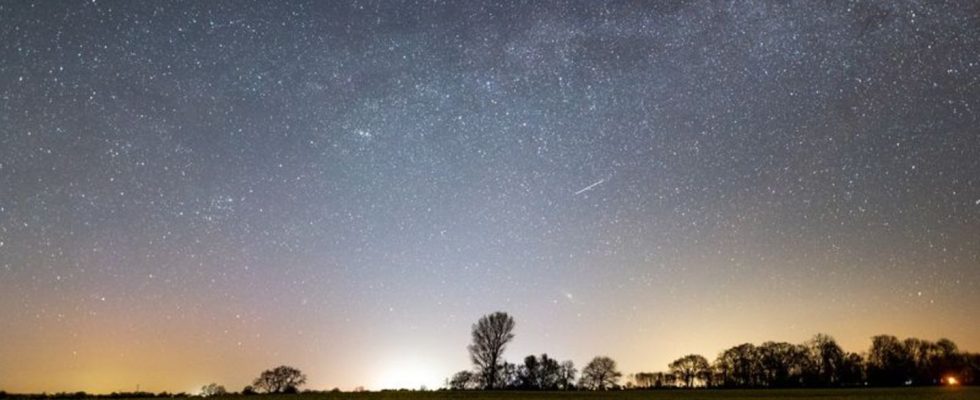astronomy
Sun, moon and stars in May – Aquariids are easy to observe
The starry sky shines over a rapeseed field. It’s also worth taking a look at the firmament in May (archive photo). photo
© Daniel Reinhardt/dpa
In May, the Big Dipper towers high above our heads in the night sky. Shooting star fans will also get their money’s worth – and the observation conditions are particularly good this time.
The best viewing time is from 3 a.m. onwards. The Aquarius radiant point is in the constellation Aquarius. These are fast meteors that enter the Earth’s atmosphere at around 65 kilometers per second. The Aquariids are splintered fragments of Halley’s Comet.
In May it is quite easy to find your way around the starry sky: in the evening the seven stars of the Big Dipper stand steeply above our heads. The middle star in the wagon shaft is called Mizar. He has been considered an eye examiner since ancient times. People with normal vision see a faint star just next to Mizar, called Alkor or the Little Horseman. The Arabic name Mizar means “the horse” that Alkor rides.
Double star Mizar
In binoculars or a small telescope you can see two points of light at Mizar at around 25x magnification – Mizar was the first double star to be discovered by Giovanni Riccioli in 1650. Both suns revolve around each other in elliptical orbits over 5,000 years. They are currently 50 billion kilometers apart, which is 335 times the distance between the Earth and the Sun.
In spectroscopic observations, both Mizar suns have now been revealed to be separate double stars. Mizar thus turned out to be a quadruple sun, 81 light-years away from Earth. In binoculars you can see a fine dot of light between Mizar and Alkor, which was named Sidus Ludoviciana – Ludwig’s Star – by the Nuremberg astronomer Georg Christoph Eimmart in 1691, in honor of Ludwig V, Landgrave of Hesse-Darmstadt.
Like an oversized index finger, the curved handle of the Big Dipper points to the orange Arcturus, the bear keeper, the main star in the image of the boat, the cattle herder. Arcturus is one of the ten brightest stars. It marks one corner of the spring triangle, which also includes Regulus in Leo and Spica in Virgo. The Spring Triangle now occupies the southern sky. South of the Jungfrau you come across the Raven’s Star Trapeze. The Raven is a small but memorable constellation. In the northeast, the blue-white Vega shines in the constellation Lyra. Along with Arctur, Vega is one of the two brightest stars in the northern sky.
A small semicircle of stars stands out next to Bootes. It is easy to see even if its stars are not particularly bright. It marks the ancient constellation Northern Crown, Latin Corona Borealis. According to legend, it is the jeweled crown of Ariadne, daughter of King Minos of Crete, which she wore at her wedding to Dionysius.
Star Gemma is a hundred times more luminous than the sun
The slightly brighter star in the middle of the crown is called Gemma, the gemstone. Gemma emits a blue-white light and is a hundred times more luminous than our sun. With a surface temperature of 10,000 degrees, Gemma is also significantly hotter than our sun at 5,510 degrees. It shines a hundred times brighter than our sun. Gemma’s light travels to Earth for 75 years.
The evening starry sky this May has no bright planets. Venus trails the Sun in the daytime sky and will overtake it in early June. It then appears in the evening sky in August and remains an evening star throughout the end of the year. On New Year’s Eve it becomes a conspicuous star in the early evening.
Mars in the morning sky
Mars appears in the morning sky in the last third of May. From the 20th, the Red Planet can be found in the eastern sky at dawn. Saturn in Aquarius is also a planet in the morning sky. The waning crescent moon meets the ringed planet on May 31st – a nice celestial sight low in the southeast sky around 3:30 a.m.
Jupiter will be in conjunction with the Sun on May 18th and will remain unobservable below the horizon at night. You will also look in vain for the nimble Mercury.
At the beginning of the month you can see the waning crescent moon in the morning sky. On the 5th, the moon comes close to Earth at 363,163 kilometers. Three days later, on the 8th, the new moon position will be reached at 5:22 a.m. The waxing crescent moon can be seen in the spring constellation Leo near the king star Regulus on the 15th. Two days later it passes its furthest orbit point at 404,640 kilometers. On the 23rd, the full moon phase occurs at 3:53 p.m., with the bright moon in the constellation of Libra. At the end of May you can see the waning crescent moon in the morning sky again.
The sun is heading towards the peak of its annual path, which it will reach next month. Your midday highs will increase by seven degrees. The length of the day increases by one hour and 35 minutes in Hamburg and by one hour and 15 minutes in Munich.

